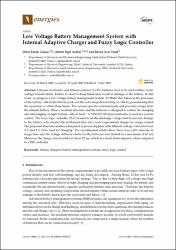Low Voltage Battery Management System With Internal Adaptive Charger and Fuzzy Logic Controller
Künye
GÖKSU, Ömer Faruk, Ahmet Yiğit ARABUL, & Revna Acar VURAL. "Low Voltage Battery Management System With Internal Adaptive Charger and Fuzzy Logic Controller." Energies, 13.9 (2020).Özet
Lithium ion (Li-Ion) and lithium polymer (Li-Po) batteries need to be used within certain
voltage/current limits. Failure to observe these limits may result in damage to the battery. In this
work, we propose a low voltage battery management system (LV-BMS) that balances the processes
of the battery cells in the battery pack and the activating-deactivating of cells by guaranteeing that
the operation is within these limits. The system operates autonomously and provides energy from
the internal battery. It has a modular structure and the software is designed to control the charging
and discharging of eight battery cells at most. A STM32F103 microcontroller is used for system
control. The fuzzy logic controller (FLC) is used to set the discharge voltage limit to prevent damage
to the battery cells, shorten the settlement time and create a specialized design for charge control.
The proposed structure enables solar panel or power supplies with di erent voltage values between
5 V and 8 V to be used for charging. The experimental results show there was a 42% increase in
usage time and the voltage di erence between the batteries was limited to a maximum of 65 mV.
Moreover, the charge current settles at about 20 ms, which is a much faster response when compared
to a PID controller.



















